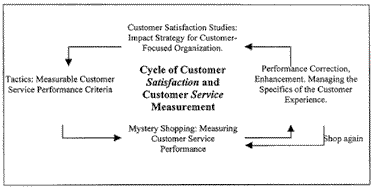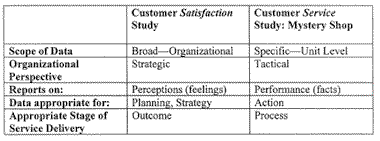Similar but different
Editor’s note: Elaine Buxton is president of Confero, a Cary, N.C., mystery shopping firm.
Every company wants to measure customer satisfaction. It is the heart of any modern business strategy. Experts estimate that most North American companies spend about 3 percent of revenues on customer satisfaction measurement. Understanding customer demographics, expectations, motivations, and desires creates an opportunity to serve customers better than competitors do. Serving customers better creates satisfied customers, builds repeat business, and drives profitability. Customer-driven companies eagerly spend that 3 percent of revenues to learn more about how they are doing with customers. Are they getting the information they ultimately need?
Customer-driven companies want customer satisfaction information on which to base long-term strategies. They also want information to help them serve customers better right now. Can one set of data serve both short-term and long-term needs? Is a customer satisfaction study a substitute for a mystery shopping study? Can mystery shopping studies be used to gauge customer satisfaction? To answer these questions, one must understand the overlaps and differences between customer satisfaction studies and customer service measurement studies, such as mystery shopping.
A customer who visited a restaurant a week ago cannot tell you with accuracy about the specific attributes of his recent visit. He probably does not remember whether he was greeted, seated, and served within a reasonable time, received piping hot food, visited a clean rest room, was served with a friendly attitude, given a check promptly, etc. All of those attributes of the visit, along with many others, combined to create a level of satisfaction in his mind. That overall satisfaction is important to the strategy of the company and will ultimately affect long term decisions. But does it help the restaurant serve customers better right now? The answer is usually no.
Revealing the “why”
Customer satisfaction studies reveal how customers feel about customer service. They do not reveal why. Customer service measurement reveals the “why” that stimulates continuous improvement. Essentially, satisfaction studies report perceptions and service studies report performance. If a satisfaction study revealed that customers thought food service was slow in a chain of restaurants, valuable information has been gleaned. Acting on this information alone would be impractical. Would the chain simply ask employees to work faster? Would it risk serving undercooked food for the sake of quick service? Would it redesign its units to receive food orders more quickly? Of course not. The chain would drill down deeper into the data to determine the root cause, the why. The chain would measure its speed of customer service, likely using mystery shoppers to take those measurements. If a subsequent mystery shopper study revealed that table-service customers were waiting an average of 10 minutes to receive their checks, a specific reason for customers to perceive slow service has been isolated. Causes for the delay can now be investigated. Causes might include slow credit card authorizations, understaffing, a backlog waiting for a manager approval, or lack of staff training to use computers. That one statistic - the more than 10-minute wait - gives managers a specific issue to work toward correcting. It gives the customer-driven company a way to serve customers better in the short term.
Think of customer satisfaction as the end product of a production line. In a retail environment, one stage of the process might involve approaching customers as they enter the store. Another stage might involve having advertised merchandise readily available, supported by prominent displays. All along the production line, customers decide how the business meets their expectations. Customer satisfaction surveys address the end product of the production line, revealing expectations and perceptions in total. By contrast, customer service measurements reveal performance at each identified stage of the production process.
 |
Taking measurements along a production line and comparing them to established benchmarks should sound familiar. It is a basic principle of total quality management (TQM) called statistical process control (SPC). SPC requires that quality be inspected at every stage of the process, not just at the end. TQM proponents equate statistical process control of a production line to mystery shopping of service businesses.
In a retail service business, mystery shopping is likely the primary means of measuring customer service delivery along the “production line.” That is because the most important stages of the production process are marked by difficult-to-measure interactions between customers and employees. Management cannot possibly witness every exchange between customer and employee. Yet so much of a customer’s ultimate satisfaction with the company centers on individual interactions. Mystery shopper studies detail specifics of those interactions, highlighting areas of success and areas needing improvement. When employee performance is critical to customer service delivery, mystery shopper studies provide a consistent performance measure of the human aspect of the service process. Because the shopper study measures specific performance, it offers opportunities to encourage desired behaviors (incentives) and discourage undesirable behaviors (training). Mystery shopping studies deal with specific performance criteria expected for each customer’s visit. Properly designed, a company’s shopper survey provides a clear blueprint for all stages in the process of serving customers. The shopper survey becomes the measure for the benchmark. Resulting data report customer service performance, as judged by the criteria set forth on the shopper survey.
Not the same
Because the shopper study involves use of a survey, it is easy to mistake it for a customer satisfaction survey. It is not. The shopper survey measures the extent to which the organization is performing to its own stated customer service standards. Inklings about customer satisfaction that emerge from shopper data are a secondary benefit, but not the primary purpose of the study. A mystery shopper’s suggestion might lead to further investigation of a future product offering. A mystery shopper’s comment might allude to a competitor’s more-favored practices. However, comments and responses from shoppers must be considered within the context of the survey.
Care must be taken to recognize the survey bias inherent in a shopper survey. When shoppers are dispatched to visit field locations, they are given the shopper survey beforehand so they will know the criteria for performance measurement. Armed with these criteria, shoppers visit the units with a specific set of expectations. Obviously, units that perform poorly do not meet the survey expectations. Since the shoppers’ expectations were trained on the survey, shoppers who report poor experiences tend to also report dissatisfaction (survey bias). It’s human nature. Answering a survey negatively makes one more likely to perceive an experience as negative.
For example, customer satisfaction studies might indicate that restaurant customers who order appetizers perceive shorter wait times for meals. Appetizers also add incremental revenue, so offering them becomes one of the company’s best practices. Offering an appetizer becomes a standard question on the shopper survey. Shoppers who visit the units and are not offered appetizers might report disappointment in not being offered an appetizer. Would an average customer report dissatisfaction about not being offered an appetizer? It’s unlikely.
Customer satisfaction studies face a different bias that is created by assumptions about customer expectations. Customer expectations come from many sources, primarily demographic, psychographic and economic. These sources collide and congeal to form an individual customer’s expectations. Many individuals must be interviewed in order to reach a reasonable conclusion about overall expectations among the target customer population. Too often, satisfaction studies assume customer expectations instead of asking for them. In an attempt to quantify results, it becomes too easy to ask customers “Do you like it when a server offers you an appetizer?” when the real question has to do with perceived wait times, not with offering appetizers.
 |
Listen for what’s missing
The goal of a satisfaction study must be to listen for what is missing, what lies ahead, what can be done to keep customers in the future. This is easy to say and difficult to do. Customers are busy people; the most highly sought-after demographic groups are busier than most. Many customers are reluctant to respond to surveys. Fewer and fewer are willing to answer yet another survey phone call, mailed questionnaire or comment card. Those who are delighted to answer the survey may not be representative of the target customer population. To secure a reasonable customer response rate, companies are often tempted to shorten the customer satisfaction survey to just a few questions so that a reasonable response rate will be received. Unfortunately, this least-common-denominator process leads to mediocre results with little actionable data. Modern customer satisfaction studies seek direction from customers, not a scorecard. Satisfaction studies that only affirm the past rather than seek the future waste time and money. Too often they are intentionally designed to affirm current management strategies rather than unearth opportunities to better serve customers.
If mystery shopping studies give shoppers a yardstick with instructions to measure in inches, satisfaction studies ask what unit of measure should be used in the first place. Shopper studies measure the process of delivering customer service (performance) while satisfaction studies measure the outcome of customer service performance (perceptions and expectations). Both measures are important to the overall health of a customer-driven organization. Both are part of an ever-repeating process of continuous improvement. In the end, there can be no customer satisfaction without customer service.
